|
|
|
Hello,
The car is a 90 240 auto sedan, 175K, that I bought a few years ago and slowly refurbished it's mechanical issues. Among it's quirks were ball joints, possibly original, installed on the wrong sides, and brand new studded winter tires on the front wheels with summer tires on the rear. The PO said he was disappointed with it's winter performance.
It's moved about 3k miles since last January when I put it on the road. I did over everything on the front end, including a stiff lower steering shaft u joint. There was some play in it after getting it loosened up with Fluid Film. I've had to replace these on every 240 I've had, usually at around 200K.
A few weeks ago the looseness in the once tight steering caught my attention. I could also hear or feel a little bump when I gently rocked the steering wheel. I checked both wheels, which were fine, but there was some play in my new steering knuckle. I ordered a new one and the next day we made a planned 200 mile return trip to Montreal. The steering was worse than before we left so I laid the car up until the part arrived.
The first thing I noticed on disassembly was that the lower bolt had lost it's torque. Probably me, I thought. The upper bolt was fine and came with the effort I would expect it to require using 2 8" 13mm wrenches.
I didn't expect any trouble with the newly greased splines, but I had a screwdriver and a hammer nearby in case they were needed. I barely touched the screwdriver into the lower slot when one arm of the casting fell out onto the floor.
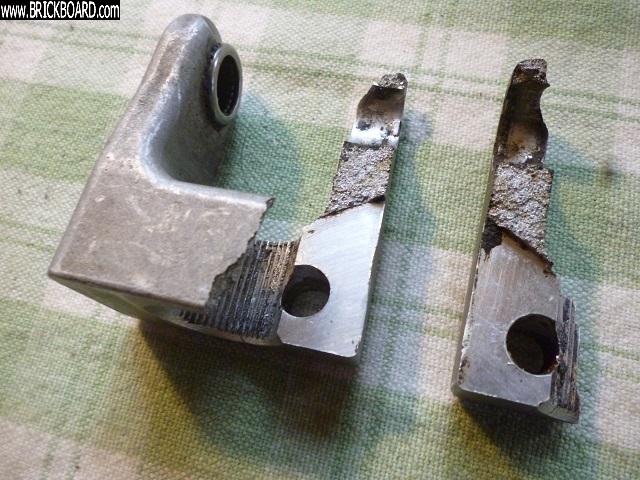
The only thing holding the thing together was the other arm which didn't look good at all.
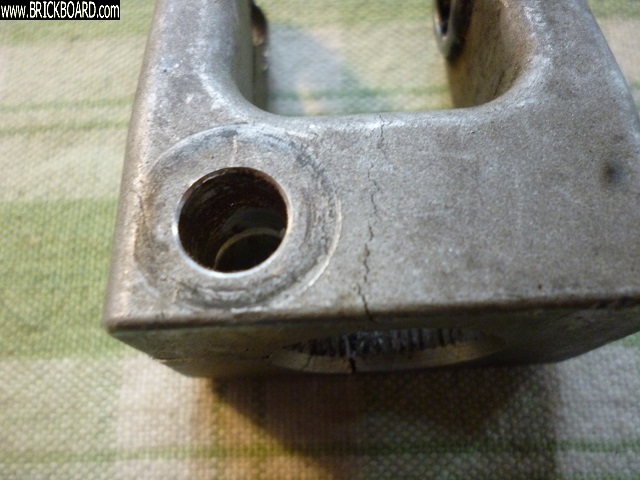
There were cracks all over the place. I put a little dye penetrant on them to help see them. I thought maybe I'd over torqued them but I don't think so. The lower crack shown on the photo below seems to have initiated on the inside of the splinned hole, opposite to the bolt's pull.
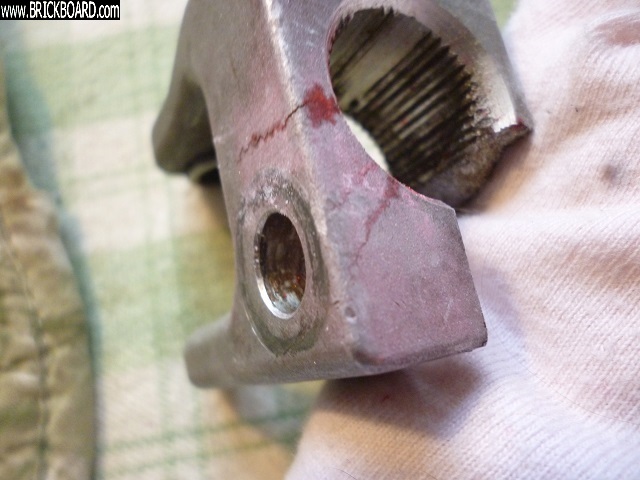
This is the top section of the joint. It didn't fail but it was sure working on it. You can't see it, but the cracks go across the top.
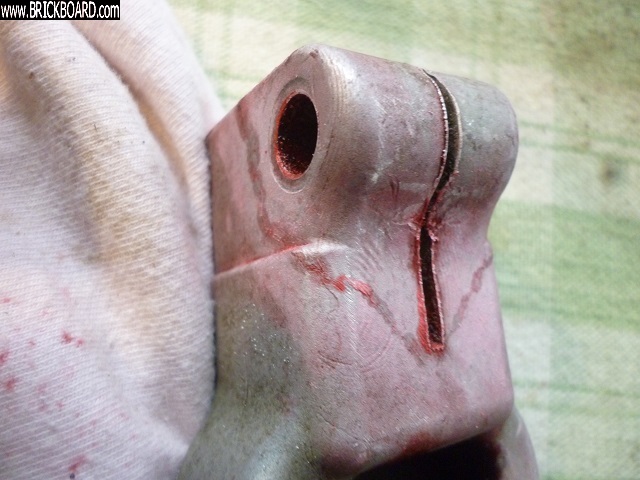
I'm not an expert on aluminum alloys but my experiences with these is that it's not a brittle material. I've had to beat the living snot out of some of these and they've always deformed. Never chipped or cracked. As to the torque, the spec is 18 Ft lbs and it's possible I gave it a little more than that, but I don't tend to over torque. It's actually one of my pet peeves with mechanics who do.
Has anyone else experienced this ? I'm wondering if it's collateral damage from something else. The rack and steering column seem secure. Some of the cracks can only be seen under magnification. I checked the new one and I couldn't find anything.
Happy Holidays
Peter
|
|
-
|
|
|
Hi Peter,
Are there any signs that the car has been in a serious front end collision in the past?
--
Bruce S. near D.C.
|
|
-
|
|
|
Hi Bruce,
No, there doesn't appear to be any. Not even a ding or a scrape, inside or out.
Peter
|
|
-
|
|
|
From what I've heard, the latest batch of aftermarket flex joints that are available are junk and I won't be surprised if 1 of them gets somebody seriously injured or killed.
In fact, a local Volvo repair shop called about 6 months ago and was willing to buy a good used 1 if we had 1.
--
Eric
Hi Performance Automotive Service (formerly OVO or Old Volvos Only)
Torrance, CA 90502
hiperformanceautoservice.com or oldvolvosonly.com
|
|
-
|
|
|
That is absolutely frighting!
The thought of one breaking at speed!
Talk about a week link!
I changed both long ago when there was some looseness in the steering. Fixed it completely. Everyone else seems to have experienced stiffness. I'm inspecting mine tonight.
|
|
-
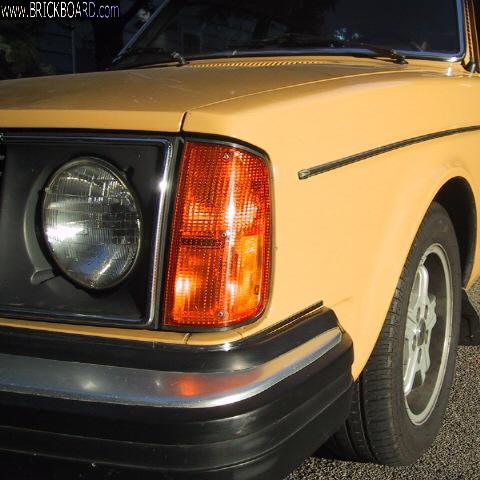
|
|
Failing due to age?
Failing due to manufacturing defect?
Failing due to having had the, "living snot," beat out of it?
I will say this, though. The earlier models had steering u-joints made of ductile iron. These were always easier to deal with. Loosen the clamp and they slip right off. Never any problem removing/installing them. Never seen one fail like the one in your post.
--
'79 242, '84 DL 2 door, '80 DL 2 door, '89 DL Wagon, '15 XC70 T6 AWD
|
|
-
|
|
|
I would think this is an aluminum alloy mistake.
As you, I ever removed one by prying and pushing a flat screw driver with a hammer and it was resistant.
Those multiple cracks show that the metal is brittle and weak all over the part.
It is my opinion.
You were lucky it did not fail on the road.
|
|
-
|
|
|
Salut mon vieux,
Yes Roland, I feel like I was very lucky. If I'd lost my steering on the autoroute at 70 mph with traffic it could have been a very, very bad day. I also feel dumb for not taking the warning signs more seriously, and part of the reason for posting was to advise others to not make the same potentially fatal mistake.
I think your opinion is valid. Although more investigation is needed to make it conclusive, the evidence is pointing to the material as a prime suspect.
The failed casting broke in 2 parts at 3 locations. All 3 showed classic brittle fractures with large, coarse crystals (grains), and no evidence of tearing. The lack of any yielding before fracture is evident because when I snap the 2 pieces together, the crystals lock into each other, the crack almost disappears, and the edges of the milled slot are perfectly parallel.
Besides that, there is one crack inside the bore that runs into one of the drilled bolt holes. It runs into one side of the hole and then reappears on the other side, looking very much like the crack had formed before the drilling took place.
I used to have contacts at a lab where I could get chemical analysis and tensile testing for beer, but they've all retired by now. I think I can get by with comparing properties of old joints that wore out. I'll look at crystal size and structure, do some guided bend tests to access ductility, and try to replicate the failure on the bench with a steering shaft and knuckles. I'm pretty sure the joint should be able to deform enough so that the bottom corners of the slot make contact. There's a picture of one that appears to be that way in the Bentley manual, p.640-4.
regards, Peter
|
|
-
|
|
|
Peter,
Now you're talking like an engineer! And I like your pictures and testing too!
I agree with your diagnosis. That piece was defective from the start. Even if you had over-torqued the bolts, one wouldn't expect the failure to occur vertically through the clevis. That part has cracks all over! Cast material, especially in this application, should have more than enough ductility to deform without failing.
Wishing you a safe and Happy Holiday,
Will
--
XC60 / Odyssey
|
|
-
|
|
|
You over torque them. 18 lbs is just snugged. Doesn't take much force to lock down a split thread. Use a new nylon lock nut. I always add a little blue loc-tite to the thread.
|
|
-
|
|
|
Hi Nahtanha,
Yes, that was the conclusion I first jumped to when the broken casting fell to the floor, and also why I made a mental note of the torque on the second bolt.
This morning I did some experimenting in my shop. I have a small 3/8 drive torque wrench measuring 0-50 inch pounds, and a 1/2 drive with a range of 200- 1200 inch pounds. ( 16.6 - 100 foot lbs.)
I set up a clean 8 mm bolt in my vise with a spacer, a clean washer and a flare nut. I set it finger tight and applied the smaller torque wrench. The nut moved to 24 inch pounds or a little more but did not move any more despite the wrench continuing on it's path to it's limit. So for my purposes, I'm going to define 'snug' as 2-3 ft. lbs.
I marked the nut and bolt head with soapstone, and tried to simulate the torque I would have used to tighten the bolt on the u joint using the same 8" box end wrench. It moved the nut between 1/6 and 1/4 revolutions on multiple tries. I then set the larger torque wrench to 225 inch lbs. (18.75 ft lbs.), which moved the nut about 1/8 revolution further. Loosening the nut, it took as much effort as the original nut on the u-joint. To me it felt secure, tight enough and wasn't going to loosen.
I repeated the whole mess over, except that I increased the final torque to 25 ft. lbs. It felt over torqued to me, and I'm confident that I wouldn't have made it that tight.
My conclusion is that over torqueing is highly unlikely to be a cause of the failure.
Regards, Peter
|
|
|
|
|





